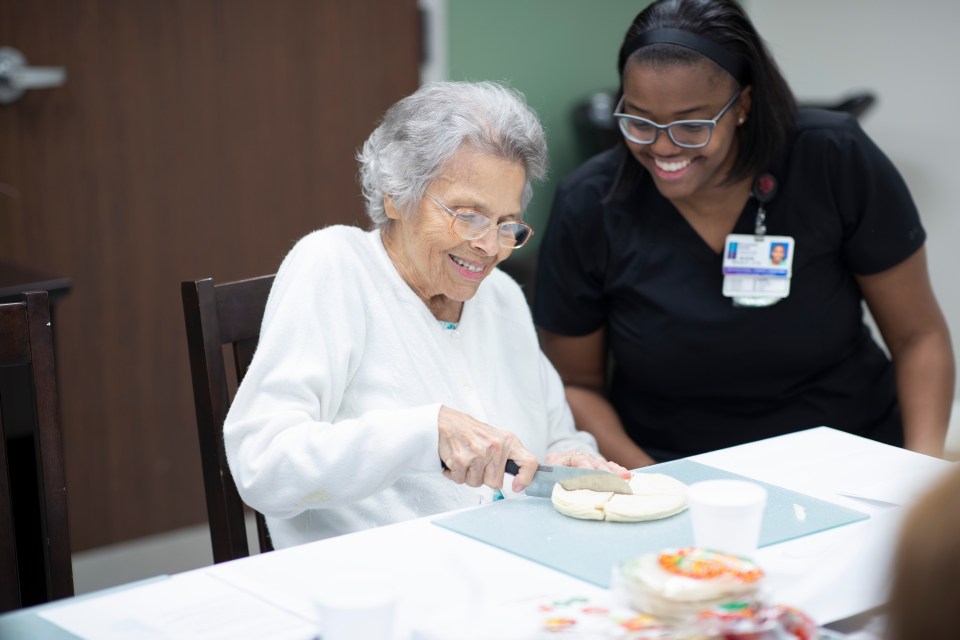After a stroke or other life-changing illness, therapy patients receive can take many forms. Encompass Health’s functional approach to therapy takes rehabilitation outside of the therapy gym and into the kitchen, helping patients gain confidence in skills they use in everyday life at home.
Several times a week, Encompass Health Rehabilitation Hospital of Altamonte Springs holds a cooking class for patients. Hosted by a group of physical therapists, occupational therapists and speech therapists, the group welcomes patients who would benefit from and enjoy cooking—and learning—in a full kitchen.
Cooking as functional therapy
After a stroke, navigating the kitchen can be challenging in a multitude of ways. By immersing patients in a kitchen complete with working appliances they have in their home, therapists can help them develop the skills they will need to be successful after discharge.
“The fun thing about being able to work in this setting is that it allows us to also work on the skills they’ll need at home,” said Alicia Wright, occupational therapist assistant. “We work on standing long enough to cook at the stove, the fine motor skills and coordination needed to cut and chop and how to safely reach into cabinets and the bottom of the refrigerator without losing balance. We cater the needs of the meal to what each individual needs to work on.”
For example, a patient may have a low tolerance for standing. Their therapist will work with them on ways to conserve energy to be able to safely stand at the stove. Another patient may have recently suffered a stroke and may need to learn how to cut ingredients one handed. This also gives therapists the opportunity to begin to incorporate adaptive equipment like a rocker knife or weighted utensils if needed.
“We not only cook, we provide education,” Wright said.

Heart smart Fridays guided by the American Heart Association
Though all recipes created are nutritionally balanced, each Friday, the cooking class focuses on sharing heart healthy recipes with patients who have cardiac conditions that require a modified diet.
Therapists teach patients how to incorporate healthy options into their diet by using simple techniques and strategies to help lower sodium, carbohydrates and cholesterol. They also educate patients on healthier ways to make their favorite dishes.
Many patients are already overwhelmed with adapting to their new normal after a life-changing illness, Wright said. Receiving education and practicing preparation firsthand can make dietary restrictions an easier adjustment for patients to make when they return home.
“Take stroke for example, diet is very important to prevent a recurring stroke and many patients are overwhelmed with that,” Wright said. “They’re used to eating a certain way for their entire life and now are being told to limit salt and cholesterol. This can be difficult to navigate on their own so having someone who is trained and educated in that can go a long way.”
Dietitians also stop by during the cooking classes to talk to patients about healthy eating.
“We’ll look at the labels on cans, packages and bottles and discuss how something has a large amount of sodium,” Wright explained. “We’ll discuss what we can do to bring this down. Is there a better brand? Should we look for something that says lower sodium or cholesterol?”
Most recipes come from the American Heart Association’s cookbook. Recipes include healthier takes on classic comfort food such as nachos, pizza, chicken and ice cream—and of course, vegetables. The cookbook is available for patients to purchase and use as a resource once they have returned home.

Nachos a la Encompass Health Altamonte Springs
Looking to liven up this classic fun fare? Traditional nachos can be packed with calories and sodium. Here’s how to make them the Encompass Health way.
- Instead of purchasing pre-made tortilla chips, cut corn tortillas and bake them in the oven using only a small amount of oil for crisping. Be careful not to burn them. Baking your own chips can lower fat and sodium by almost 40 percent compared to those purchased in stores.
- Use cumin on the chips instead of salt to add flavor while keeping sodium counts down.
- Instead of ground beef, top your nachos with leaner meats such as chicken or turkey.
- Substitute sour cream with non-fat greek yogurt and extra fresh vegetables. Also, opt for a low fat, low sodium cheese—because who wants nachos without cheese?
The content of this site is for informational purposes only and should not be taken as professional medical advice. Always seek the advice of your physician or other qualified healthcare provider with any questions you may have regarding any medical conditions or treatments.



